GIMP and Some Crappy Photos from Dayang
November 19th and 20th was to be the final dive trip to Dayang Island before it closes for the monsoon season in 2005. I have just bought a new digital camera after weeks of research into which affordable digital camera that will hopefully give me some good underwater pictures. Finally I settled on the Canon A610 with the WP-DC90 housing. This will be my first time using a camera underwater.
Not unexpectedly most of the photos were really crappy. Only about 3 out of 200+ photos were good enough to use as is. However a really nice piece of software came to my rescue. No it’s not Photoshop – it’s an incredible piece of software but I can’t afford it. Instead I use something almost as good – GIMP. It’s free! I’ll tell you more about GIMP later.
Dayang Island Resort
This is my first time to Dayang. I was warned by others that the resort is very basic, the food basic, the boat ride uncomfortable and the dive sites crowded. They were right! Dayang is mostly frequented by divers from Singapore. In this trip I think I was the only Malaysian on board (other than the crew… but then again they could be Indonesian). My group consisted of all Japanese – dive friends of my wife.
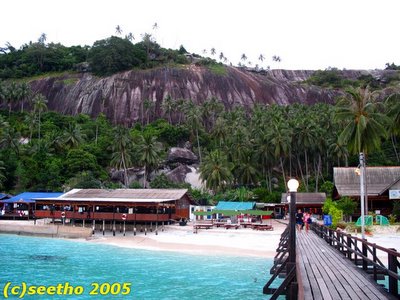
Dayang Island Resort.
The boat is crowded and this is not peak period for Dayang trips. I hate to see it when the boat is really full.
On the way from Mersing, just past midnight, it rained and everyone had to jam into the lower cabin. There was hardly enough space for everyone. The rain was seeping through the upper deck and leaks were everywhere. I don’t think any of us managed any sleep in the hot, wet and stuffy conditions.
The next morning we arrived after 4am. All of us just went straight to our assigned bunks and I managed about 2 of sleep, skipping the early morning dive.
After breakfast I went for a checkout dive. I didn’t take my camera as I was unsure of the conditions there. The second dive onwards I had my camera with me. In all I made 5 dives with the camera and all I got were crappy pictures. I seriously needed some digital help to salvage my trip.
GIMP
“GIMP is the GNU Image Manipulation Program. It is a freely distributed piece of software for such tasks as photo retouching, image composition and image authoring. It works on many operating systems, in many languages.”- excerpt from the official GIMP web-site.
GIMP was created 10 years ago somebody who wanted something with the capabilities of Adobe Photoshop. Photoshop is an excellent piece of software but it is expensive. Most people (me included) will not be able to afford it. I’d rather save the money to buy a strobe.
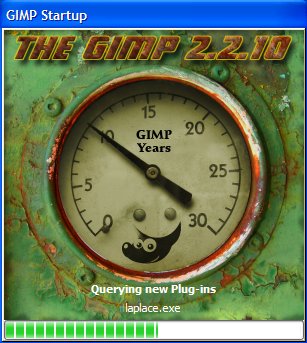
For the purpose of improving the look of your digital photos, GIMP is more than capable. In fact in the help file, you can find specific information about how to improve your digital photos.
What I did to my photos
I don’t have an external strobe, so almost all my photos suffer from poor colour balance. More than half of them turned out green and completely useless. Some of them had enough of the other colour in them to be rescued by doing white balance adjustments in GIMP. Most of the time I use the Auto-White-Balance function. It works well most of the time. Only occasionally do I need to resort to manually adjusting the white balance.
Beside white balance adjustments you can also adjust the contrast level and colour saturation to give you more vivid colours and avoid that washed out look.
Another problem I noticed from my photos is that they were almost always poorly composed. It’s not easy getting a well composed picture underwater especially in strong current, and most of the time the “models” are very uncooperative. This can be fixed rotating the image and then cropping. I always crop my images to improve the composition. The results can be very dramatic. 5 megapixels is enough to allow some very liberal cropping.
Another very useful tool is the smudge tool that I normally use to remove some annoying bright specks resulting from backscatter.
Other tools available like noise reduction and sharpening filters are available but I rarely use them. I don’t want an artificial look to my photos.
The results
Instead of just having 3 images to show for this trip, I now have a few more presentable images thanks to GIMP.
Overall I must say that it’s not a bad effort for a first time – sleep deprived – underwater photographer with a very basic camera setup.
I did improve on my second outing to Jarak (see earlier post) and I hope to continue improving. If I do get a crappy shot now and then I know that there’s still hope with GIMP around.
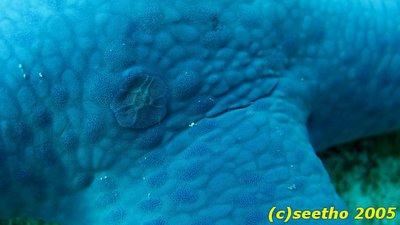
Giant blue starfish – Linckia laevigata. The disc is the madreporite – a porous sieve like plate that allows the starfish to draw in water into its vascular system. Water pressure is used in keeping its shape and in locomotion.
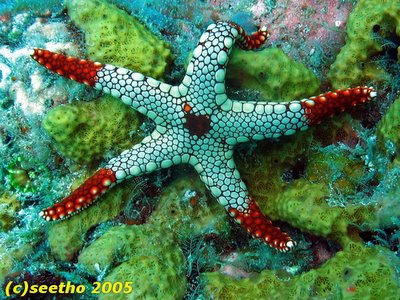
Starfish - Fromia monolis.
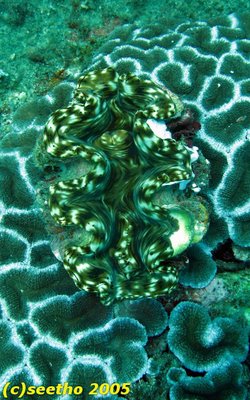
A small giant clam – Tridacna maxima. Listed in the IUCN Red List of threatened species. Giant clams grow to enormous sizes by having a symbiotic relationship with zooxanthallae algae which is found within its mantle tissue. The algae like in coral polyps produce food for the giant clam – up to 90% of these clams requirements. Like coral, these clam require sunlight to allow the zooxanthallae to function.
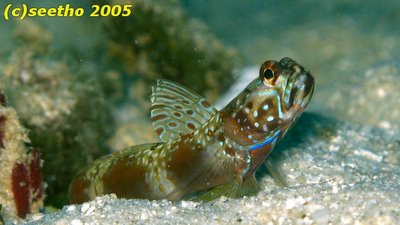
Metallic shrimp-goby - Amblyeleotris latifasciata. I only managed one shot before it quickly disappeared into its burrow.
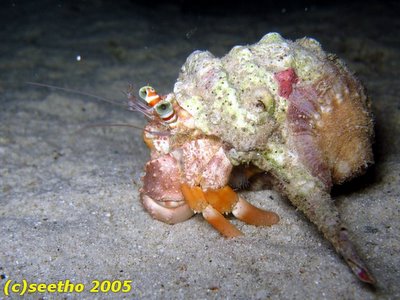
Fist size hermit crab. It kept turning away from me. Probably very camera shy.
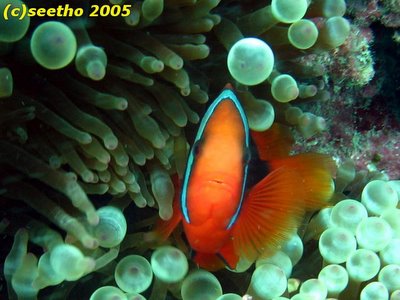
Tomato anemone fish – Amphirion frenatus. This female is aggressively defending its patch of Bulb-tentacle anemone - Entacmaea quadricolor.
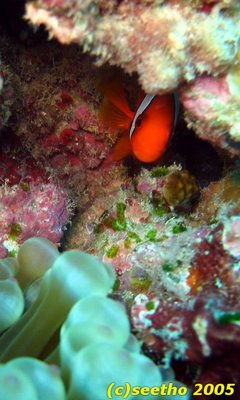
The much smaller male hides from the bubble blowing monster.
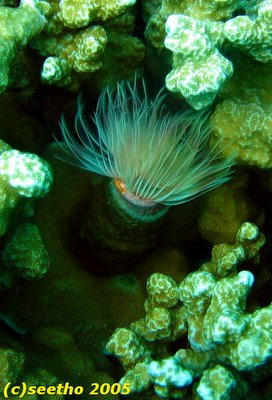
Polychaete worm embedded in coral.

Bridled monocle bream – Scolopsis bilineatus. The one photo from this trip that I did not have to crop to improve the composition. It was just sitting there posing (or sleeping). At one point I got too close that the front of the camera bumped into it, but still it didn’t budge.
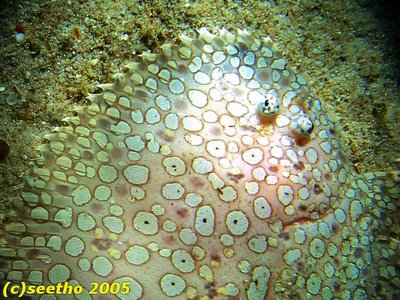
Peacock sole – Pardachirus pavoninus. We saw two small specimens of these in one night dive. This photo was illuminated by my dive light only.
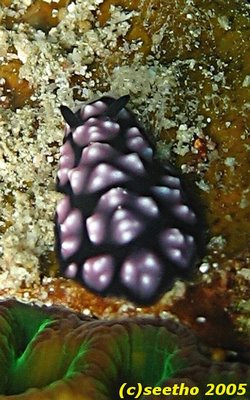
Nudibranch – Phyllidiella pustulosa.
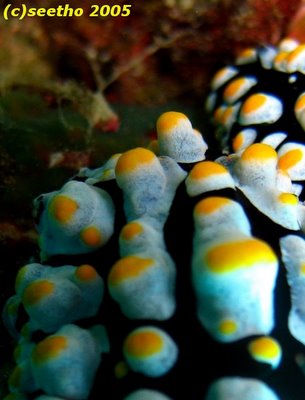
A pair of Phyllidia varicosa caught making out.
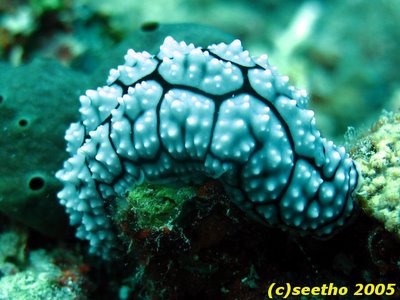
Nudibranch – Phyllidia elegans.

Nudibranch – Fryeria menindie.
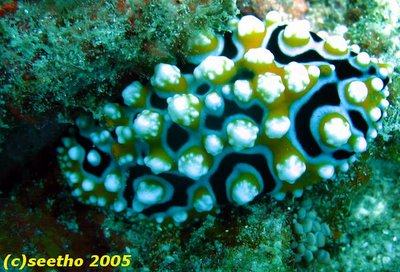
Nudibranch – Phyllidia ocellata.

Storm approaching Dayang (left) and Aur (right). This was taken just before we were scheduled to return to Mersing. It did actually catch up with us resulting in a very uncomfortable boat ride.
Not unexpectedly most of the photos were really crappy. Only about 3 out of 200+ photos were good enough to use as is. However a really nice piece of software came to my rescue. No it’s not Photoshop – it’s an incredible piece of software but I can’t afford it. Instead I use something almost as good – GIMP. It’s free! I’ll tell you more about GIMP later.
Dayang Island Resort
This is my first time to Dayang. I was warned by others that the resort is very basic, the food basic, the boat ride uncomfortable and the dive sites crowded. They were right! Dayang is mostly frequented by divers from Singapore. In this trip I think I was the only Malaysian on board (other than the crew… but then again they could be Indonesian). My group consisted of all Japanese – dive friends of my wife.

Dayang Island Resort.
The boat is crowded and this is not peak period for Dayang trips. I hate to see it when the boat is really full.
On the way from Mersing, just past midnight, it rained and everyone had to jam into the lower cabin. There was hardly enough space for everyone. The rain was seeping through the upper deck and leaks were everywhere. I don’t think any of us managed any sleep in the hot, wet and stuffy conditions.
The next morning we arrived after 4am. All of us just went straight to our assigned bunks and I managed about 2 of sleep, skipping the early morning dive.
After breakfast I went for a checkout dive. I didn’t take my camera as I was unsure of the conditions there. The second dive onwards I had my camera with me. In all I made 5 dives with the camera and all I got were crappy pictures. I seriously needed some digital help to salvage my trip.
GIMP
“GIMP is the GNU Image Manipulation Program. It is a freely distributed piece of software for such tasks as photo retouching, image composition and image authoring. It works on many operating systems, in many languages.”- excerpt from the official GIMP web-site.
GIMP was created 10 years ago somebody who wanted something with the capabilities of Adobe Photoshop. Photoshop is an excellent piece of software but it is expensive. Most people (me included) will not be able to afford it. I’d rather save the money to buy a strobe.

For the purpose of improving the look of your digital photos, GIMP is more than capable. In fact in the help file, you can find specific information about how to improve your digital photos.
What I did to my photos
I don’t have an external strobe, so almost all my photos suffer from poor colour balance. More than half of them turned out green and completely useless. Some of them had enough of the other colour in them to be rescued by doing white balance adjustments in GIMP. Most of the time I use the Auto-White-Balance function. It works well most of the time. Only occasionally do I need to resort to manually adjusting the white balance.
Beside white balance adjustments you can also adjust the contrast level and colour saturation to give you more vivid colours and avoid that washed out look.
Another problem I noticed from my photos is that they were almost always poorly composed. It’s not easy getting a well composed picture underwater especially in strong current, and most of the time the “models” are very uncooperative. This can be fixed rotating the image and then cropping. I always crop my images to improve the composition. The results can be very dramatic. 5 megapixels is enough to allow some very liberal cropping.
Another very useful tool is the smudge tool that I normally use to remove some annoying bright specks resulting from backscatter.
Other tools available like noise reduction and sharpening filters are available but I rarely use them. I don’t want an artificial look to my photos.
The results
Instead of just having 3 images to show for this trip, I now have a few more presentable images thanks to GIMP.
Overall I must say that it’s not a bad effort for a first time – sleep deprived – underwater photographer with a very basic camera setup.
I did improve on my second outing to Jarak (see earlier post) and I hope to continue improving. If I do get a crappy shot now and then I know that there’s still hope with GIMP around.

Giant blue starfish – Linckia laevigata. The disc is the madreporite – a porous sieve like plate that allows the starfish to draw in water into its vascular system. Water pressure is used in keeping its shape and in locomotion.

Starfish - Fromia monolis.

A small giant clam – Tridacna maxima. Listed in the IUCN Red List of threatened species. Giant clams grow to enormous sizes by having a symbiotic relationship with zooxanthallae algae which is found within its mantle tissue. The algae like in coral polyps produce food for the giant clam – up to 90% of these clams requirements. Like coral, these clam require sunlight to allow the zooxanthallae to function.

Metallic shrimp-goby - Amblyeleotris latifasciata. I only managed one shot before it quickly disappeared into its burrow.

Fist size hermit crab. It kept turning away from me. Probably very camera shy.

Tomato anemone fish – Amphirion frenatus. This female is aggressively defending its patch of Bulb-tentacle anemone - Entacmaea quadricolor.

The much smaller male hides from the bubble blowing monster.

Polychaete worm embedded in coral.

Bridled monocle bream – Scolopsis bilineatus. The one photo from this trip that I did not have to crop to improve the composition. It was just sitting there posing (or sleeping). At one point I got too close that the front of the camera bumped into it, but still it didn’t budge.

Peacock sole – Pardachirus pavoninus. We saw two small specimens of these in one night dive. This photo was illuminated by my dive light only.

Nudibranch – Phyllidiella pustulosa.

A pair of Phyllidia varicosa caught making out.

Nudibranch – Phyllidia elegans.

Nudibranch – Fryeria menindie.

Nudibranch – Phyllidia ocellata.

Storm approaching Dayang (left) and Aur (right). This was taken just before we were scheduled to return to Mersing. It did actually catch up with us resulting in a very uncomfortable boat ride.
<< Home